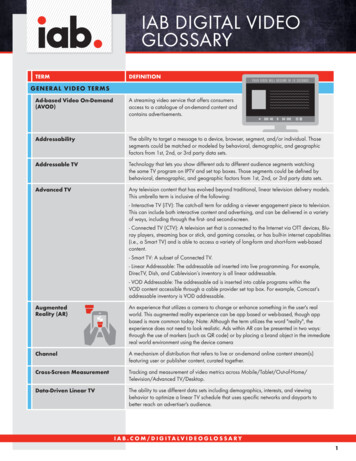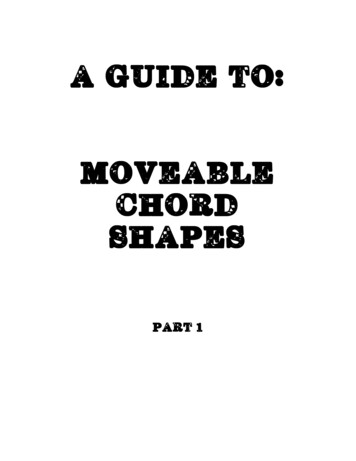
Transcription
IAB DIGITAL VIDEOGLOSSARYTERMDEFINITIONYOUR VIDEO WILL RESUME IN 10 SECONDSGENERAL VIDEO TERMSAd-based Video On-Demand(AVOD)A streaming video service that offers consumersaccess to a catalogue of on-demand content andcontains advertisements.AddressabilityThe ability to target a message to a device, browser, segment, and/or individual. Thosesegments could be matched or modeled by behavioral, demographic, and geographicfactors from 1st, 2nd, or 3rd party data sets.Addressable TVTechnology that lets you show different ads to different audience segments watchingthe same TV program on IPTV and set top boxes. Those segments could be defined bybehavioral, demographic, and geographic factors from 1st, 2nd, or 3rd party data sets.Advanced TVAny television content that has evolved beyond traditional, linear television delivery models.This umbrella term is inclusive of the following:- Interactive TV (iTV): The catch-all term for adding a viewer engagement piece to television.This can include both interactive content and advertising, and can be delivered in a varietyof ways, including through the first- and second-screen.- Connected TV (CTV): A television set that is connected to the Internet via OTT devices, Bluray players, streaming box or stick, and gaming consoles, or has built-in internet capabilities(i.e., a Smart TV) and is able to access a variety of long-form and short-form web-basedcontent.- Smart TV: A subset of Connected TV.- Linear Addressable: The addressable ad inserted into live programming. For example,DirecTV, Dish, and Cablevision’s inventory is all linear addressable.- VOD Addressable: The addressable ad is inserted into cable programs within theVOD content accessible through a cable provider set top box. For example, Comcast’saddressable inventory is VOD addressable.AugmentedReality (AR)An experience that utilizes a camera to change or enhance something in the user's realworld. This augmented reality experience can be app based or web-based, though appbased is more common today. Note: Although the term utilizes the word "reality", theexperience does not need to look realistic. Ads within AR can be presented in two ways:through the use of markers (such as QR code) or by placing a brand object in the immediatereal world environment using the device cameraChannelA mechanism of distribution that refers to live or on-demand online content stream(s)featuring user or publisher content, curated together.Cross-Screen MeasurementTracking and measurement of video metrics across Mobile/Tablet/Out-of-Home/Television/Advanced TV/Desktop.Data-Driven Linear TVThe ability to use different data sets including demographics, interests, and viewingbehavior to optimize a linear TV schedule that uses specific networks and dayparts tobetter reach an advertiser's audience.I A B . C O M / D I G I TA LV I D E O G LO S SA RY1
IAB DIGITAL VIDEO GLOSSARYTERMDEFINITIONLive Streaming VideoVideo content streamed digitally in real time as the event orprogram takes place. Content can be streamed on mobiledevices, computers, smart TVs, or internet-enabled TVs.LIVE STREAMING VIDEOMulti-Channel Network (MCN)A standalone entity that leverages digital video platforms to enable content producersto program, promote, monetize, and distribute their content as well as offer technicalassistance in exchange for a percentage of the ad revenue earned.Multi-Channel VideoProgramming Distributor(MVPD)A service provider that delivers video programming services, usually for a subscription fee(pay television). Usually includes cable, satellite, and telecommunications service providers.Subscription Video On-Demand(SVOD)A streaming service that consumers subscribe to for a fee and can access a catalogue ofon-demand contentTV EverywhereAn online business model in which television broadcasters, particularly cable networks,allow their customers to access live and/or on-demand video content from their networksthrough Internet-based services. The fee for such access is covered as part of theirsubscription to the service, via an MVPD. The viewers use credentials from their MVPD forauthentication and access to the content.User Generated Content (UGC)Content that is voluntarily generated by individuals* that has the potential to createengagement and/or drive conversation. *Individuals are defined as those who do not havea material connection with a brand. This would exclude paid influencers or professionalbloggersVideo Aspect RatioVideo comes in several aspect ratios. The two main ones are widescreen (16:9) andstandard (4:3). The aspect ratio of an image describes the proportional relationshipbetween its width and its height. It is commonly expressed as two numbers separated bya colon, i.e., 16:9. Preferred aspect ratio is 16:9 (formatted for HD screens). For verticalvideo, the recommended aspect ratio is 9:16 (most phones), 3:4 (iPad), and 10:16 & 2:3(other phones/tablets). For more information please refer to the Digital Video In-Stream AdFormat Guidelines doc section 2.2.1. This document provides useful information on framerate, audio data, etc. We also refer to HLS and recommend using these files to createthe adaptive bitrate file fragments. In addition, section 2.2.2 focuses on SSAI through a“Mezzanine file” that can easily be used to transcode on the fly.Video On Demand (VOD)Video content that is controlled, enabled, and consumed whenever a viewer wants afterits official release date or original air date and time. VOD content can be found on set topboxes, OTT devices, mobile web, mobile apps, and video streaming services.Virtual MVPD (vMVPD)New form of digital-only cable alternative which provides access to on-demand and livecontent delivered over the internet without the traditional network infrastructure (i.e.DirecTV Now, Hulu with Live TV, PlayStation, Sling TV, Vue).I A B . C O M / D I G I TA LV I D E O G LO S SA RY2
IAB DIGITAL VIDEO GLOSSARYTERMDEFINITIONVirtual Reality (VR)An experience that is made to be significantly more immersive than standard videoassets. VR allows a user to be completely immersed into an environment of the marketer’schoice. Ads within VR must occur within either a designated ad space (such as street sidebillboard), as a video (that might play in avirtual home TV or virtual movie theater), or asan object (such as a branded bag of potatochips on the table). Fully branded 3D scenescan also be created as “virtual rooms.”AD & CREATIVE TYPE TERMS360 Video Ads360-degree videos, also known as immersive videos or spherical videos, are videorecordings where a view in every direction is recorded at the same time, shot using anomnidirectional camera or a collection of cameras. During playback the viewer has controlof the viewing direction like a panorama. These types of ads can be served withoutrequiring a VR headset, using keyboard/mouse/touch controls or motion sensors insmartphones/tablets to control the viewing orientation.Ad PodAn individual ad pod is a group of ads expected to play back-to-back in one commercialad break similar to how consumers experience commercial ad breaks in broadcasttelevision. An ad pod can be of varying lengths and can be inserted at any point in astream of content (pre, mid, or post).Autoplay Video AdA video ad or an ad linked with video content that initiates ‘‘play’’ without user interactionor without an explicit action to start the video (essentially automatically starting without a‘‘play’’ button being clicked by the user).Branded Video ContentVideo content that is supported by a brand and is nonpromotional in nature. It grabs the attention of theconsumer and drives engagement through content.0:00 BRAND3:00Dynamic CreativeVideo ad creative customized in advance and/or able to transform itself upon deliveryto target relevant audience segments. Customization may include delivering a specificcombination of ad content such as the copy, the background images, and the size andcolor of the call-to-action button.In-Stream Video AdPlayed before, during or after the streaming video content that the consumer has requested(Pre-roll, Mid-roll, Post-roll). These ads cannot typically be stopped from being played(particularly with pre-roll) but can sometimes be skipped. This format is frequently used tomonetize the video content that the publisher is delivering. In-Stream Video Ads can beplayed inside short or long-form video and rely on video content for their delivery. Thereare four different types of video content where in-stream may play: UGC (User GeneratedContent/Video), Syndicated, Sourced and Journalistic. In-Stream Video Ads are displayedwithin the context of streaming video content.I A B . C O M / D I G I TA LV I D E O G LO S SA RY3
IAB DIGITAL VIDEO GLOSSARYTERMDEFINITIONInteractive VideoA type of digital video creative that can take user input to perform some enhanced actionsthrough elements integrated above and beyond the standard video playback controls(i.e., play, pause, rewind, and mute). These interactions can include varied calls-to-actions,forms, polls/surveys, links, chapter menus and hot-spots that may affect story progressionof the video content and/or drill down on specific parts of the content itself. The goalof the creative is to give the user various options to engage with the message beyondviewing the video.InterstitialVideo AdADVideo ads that occur between two content pages. These formats are most often found inapps. They are considered less disruptive as they occur during natural transition pointsfor a consumer.Long-Form VideoVideo content that always has a content arc with a beginning, middle, and end andthat, in its entirety typically lasts longer than 8 minutes (i.e., movies and original series).If the content is ad supported, it typically contains breaks (mid-roll). This is different thancommercial videos, which typically put the product upfront and run under one minute.Native AdvertisingA form of paid media where the ad experience follows the natural form and function ofthe user experience in which it is placed. These paid ads aspire to be so cohesive with thepage content, assimilated into the design, and consistent with the platform behavior thatthe viewer simply feels that they belong.Outstream Video AdA form of video advertising that takes place outsideof In-Stream Video content. One type of outstreamvideo is in-feed video ads which are found incontent, social, or product feeds. Another type ofoutstream video ad is in-article video ads that areserved between text.Short-Form Video AdVideo content that has a duration of less than 8 minutes.Skippable Video AdVideo ads that allow viewers to skip after a predetermined number of secondsSticky Video Ad(aka adhesion ad)Video ads that are anchored to the bottom or topof the screen and follow the user as they scroll.They are allowed under the following guidance: 1.Ad height MUST be less than 25% of the screenheight. 2. The ad MUST have a clear boundary toseparate it from the content. 3. The ad MUST coverthe full width of the screen edge to edge. 4. The adMUST have a ‘close button’ above top right cornerof the ad as defined in LEAN User Experience andAd Content.Opt-In Value-Exchange Ads(aka rewarded ads)WEBSITEADPremium ads that offer consumers something in exchange for providing their time andattention. In all instances, the value exchange is opt-in. Video is a commonly used type ofopt-in value exchange placement.I A B . C O M / D I G I TA LV I D E O G LO S SA RY4
IAB DIGITAL VIDEO GLOSSARYTERMDEFINITIONVertical Video Ads“Vertical Video” is displayed in portrait mode but can be shot in portrait/landscape mode- i.e., skinny and tall video (9:16 aspect ratio), rather than the widescreen format (16:9aspect ratio) normalized by movies and television. These types of video ads are mostlydisplayed in mobile devices as they have the optimal aspect ratio to fill the whole screen.METRIC TERMSThe percentage of measurable impressions that were audible and viewable when thevideo reached completion.Audible and Viewable onComplete (AVOC).Cost Per Completed View(CPCV)The price an advertiser pays every time a video ad runs through to completion. Rather thanpaying for all impressions, some of which may have been stopped before completion, anadvertiser only pays for ads that finished (CPCV Cost Completed Views).Cost per point (CPP)A pricing model based on the cost of a campaign divided by each full percentage ratingpoint of a targeted demographic that the campaign successfully reaches.Cost per view (CPV)A pricing model where the advertiser only pays for a video start. Typically sold at 1000impressions.Cost per viewable impression(CPVI or VCPM/VCPV)A pricing model where the advertiser only pays for video ad impressions that areconsidered viewable based upon MRC and IAB viewability guidelines. Typically sold at1000 impressions.Gross Rating Point (GRP)A term used to measure the size of an audience reached by a specific media vehicle orschedule. It is used to measure the exposure to one or more programs or commercials,without regard to multiple exposures of the same advertising to individuals. For example, anadvertisement that is aired/served 5 times reaching 50% of the target audience each timeit is aired would have a GRP of 250 (5 x 50%). GRP values are typically used by mediabuyers to compare the advertising strength of various media vehicles.QuartilesPercentage of video ad viewed continuously at a normal speed. If a rewind event occursduring play, percent complete may be calculated on total amount of unduplicated videoviewed at normal speed. Each section of the video may only be considered once in thecalculation. This definition governs the triggering of any “partial play” metrics, such as thecommon quartile percentages (25%, 50%, 75%), most commonly tracked as first quartile(the creative played continuously for at least 25% of the total duration at normal speed),midpoint (the creative played continuously for at least 50% of the total duration at normalspeed), and third quartile (the creative played continuously for at least 75% of the durationat normal speed). Specifically, reporting on any partial play should be the result of howmuch of the ad was played at normal speed. Publishers and marketers may measureprogress in different increments in addition to these percent complete quartiles, but thesequartiles offer a baseline measurement and should be used whether or not other methodsare used.Target Rating Point (TRP)The percentage of an advertiser’s target audience that sees its commercials, advertisements,or campaign. Typically advertising is bought against a guaranteed demographic oraudience segment. The TRP expresses that guaranteed audience.I A B . C O M / D I G I TA LV I D E O G LO S SA RY5
IAB DIGITAL VIDEO GLOSSARYTERMDEFINITIONVideo ad completionWhen a video ad starts and plays through its entire duration to completion.Video ad completion rate (VCR)The percentage of all video ads that play through theirentire duration to completion. Also known as VideoCompletion Rate (VCR). Not to be confused with thevideocassette recorder.Viewability RateThe percentage of video ad impressions that were deemed viewable as per the videoviewability definition of the measurement vendorViewable video impressionA desktop video ad or mobile video ad that meets the criteria of: (i) Desktop: 50% of thead’s pixels on an in-focus browser tab in the viewable space of the browser page that hasmet the time criterion that two continuous seconds of the video advertisement is played.(ii) Mobile: 50% of the ad’s pixels on an in-focus browser or a fully downloaded, opened,initialized application, on the viewable space of the device that has met the time criterion thattwo continuous seconds of the video advertisement is played. (iii) For both desktop video andmobile video, the required time is not necessarily the first two seconds of the video ad; anyunduplicated content of the ad comprising two continuous seconds qualifies in this regard.TEC HNOLOGY TERMSAdaptive Bitrate Streaming(ABS)Adaptive streaming is a technical process that adjusts the quality of a video delivered tothe client/video player of a connected device based on changing network conditions,video buffer status, and CPU utilization to ensure the best possible viewer experience. Thevideo quality is determined and set by real time detections of a user’s available bandwidth(throughput), video buffer capacity and CPU utilization. Based on these conditions thebitrate is adjusted in real time to ensure the best possible quality.Automated Content Recognition(ACR)ACR is an opt-in identification technology embedded in a device that allows content tobe recognized by video, audio or watermark cues and matched back to a database forverification. This technology can recognize content regardless of its distribution source (i.e.OTT, linear, etc.). Marketers use this information to understand when a consumer has seentheir ads.I A B . C O M / D I G I TA LV I D E O G LO S SA RY6
IAB DIGITAL VIDEO GLOSSARYTERMDEFINITIONBitrate or bit rateEncoded bit rate: The number of bits (or amount of data) per second that has been usedto store a media signal. In audio, this usually is presented in kilobits per second (or kb/sor kbps), while for high-quality video, this might be presented in megabits per second (orMbps, or Mb/s). For example, the music you buy on iTunes is 256 kilobits per second,meaning there are 256 kilobits of data stored in every second of a song, and an HD videofile might be encoded at 2.0 megabits per second, meaning there are two megabits ofdata.The encoded bit rate is the one used for business requirements as it represents a strongsignal of fidelity.Available bit rate: The instantaneous delivery rate of data in bits per second (bps), kilobitsper second (kbps), megabits per second (mbps), etc. from the source server to destinationdevice through one or many digital networks. The slowest portion of the network pathdetermines the end-to-end maximum bitrate of the delivered stream. Some media contentsuch as audio streams may use less than the maximum available bandwidth. HTTS LiveStreaming (HLS) is a variable bitrate protocol for delivering video content. HLS starts thestream at a low bitrate which provides low video resolution and increases the bitrate andvideo resolution as the network conditions permit.The available bit rate is used for technical purposes as it represents how much data can bepassed from the ad server to the client for an ad to deliver without jitter.Connected TV (CTV)A television set that is connected to the Internet via OTT devices, Blu-ray players andgaming consoles or has built-in Internet capabilities (i.e., a Smart Television) and is able toaccess a variety of long-form and short-form web-based content.Content Distribution Network(CDN)A service that hosts online assetsand provides content management viaservers located around the globe toreduce the latency of downloadsto users.Dynamic Ad Insertion (DAI)Technology that allows advertisers to swap out ad creatives in video on demand content.Encoding/transcoding/renditionsEncoding when referencing video or audio involves the change from one physical format toanother, i.e., the change from film to digital format, or change from analog to video.Transcoding refers to the creation of a file from one of a similar format, i.e., compressinga video file (e.g., mp4) at different bitrates from a source file (e.g., MOV). The source file,known as the mezzanine, and the resulting compressed versions of the same creative,known as renditions, are all digital in format, although they may be different dimensionsand bitrates from one another.Please note: Encoding of video should not be confused with encoding of reserved/specialcharacters in http links to pixels, click-throughs, calls to VAST, or other http assets. Moreinformation on what constitutes a character that has a special purpose in http and how theymust be percent encoded to prevent failure is detailed here.I A B . C O M / D I G I TA LV I D E O G LO S SA RY7
IAB DIGITAL VIDEO GLOSSARYTERMDEFINITIONIdentifier for Advertising onOTT (OTT IFA)The Guidelines for Identifier for Advertising (IFA) on OTT platforms are recommendationson how to maintain a high-quality advertising experience within over-the-top television(OTT) environments. These technical guidelines provide instructions on best practices fordelivering targeted ads, as well as controlling ad frequency and rotation across a widevariety of disparate smart TVs, connected devices, and other OTT systems. In order to becompliant with these guidelines, these three parameters must be sent as part of any adrequest: identifier for advertising (IFA), IFA type, and Limit Ad Tracking (lmt).Latency1) The time it takes for a data packet to move across a network connection.2) The delay between request and display of content and an ad. Latency sometimes leadsto the user leaving the site prior to the opportunity to see. In streaming media, latency cancreate stream degradation if it causes the packets, which must be received and played inorder, to arrive out of orderOver the top device (OTT)A device that can connect to a TV (or functionality within the TV itself) to facilitate thedelivery of Internet-based video content (i.e., streaming boxes, media streaming devices,Smart TV’s and gaming consoles).Over the top video (OTT Video)Over the Top Video is video content transported from a video provider to a connecteddevice over the Internet outside the closed networks of telecom and cable providers.Server-side ad insertion (SSAI)Server-side ad insertion (often referred to as “ad stitching”) is the process of stitching videocontent and ads together on the server side level rather than on the browser level (ClientSide Ad Insertion). Videos and video ads are coming from different places—videos typicallycome from a content delivery network (CDN) and ads from an ad server (video ads canalso be served from CDNs, although content CDNs and ad CDNs often differ). These arethen combined on the fly when people start watching videos. With server-side ad stitching,that combination of video and advertising happens on the backend.Server-side ad insertion allows for smoother ad user experiences as users do not have towait for players to fetch ads and render them in real time. The stitching is all done prior tothe user getting the ad break/pod. In the ad stitching process, ad specs are matched withcontent specs resulting in more consistent viewer experience as the ad quality will match thecontent quality.SSAI also allows publishers to mitigate ad blocking, as video content and ads are stitchedtogether as a cohesive stream on the server side which allows them to bypass browser ordevice-level detection/blocking. When a browser or device-level script makes a call to thead-decisioning system, the ad blocker can identify that signal, as opposed to a server-sidescript where the ads are already stitched into the player’s content, making it impossible todistinguish an ad from content.This is a great solution for a publisher, however advertisers may have concerns withmeasurement being made server side and request such delivery to be distinguished inreporting.Streaming1) Technology that permits continuous audio and video delivered to a device from a remotewebsite.2) An Internet data transfer technique that allows the user to see and hear audio and videofiles. The host or source compresses, then “streams” small packets of information over theInternet to the user, who can access the content as it is received.I A B . C O M / D I G I TA LV I D E O G LO S SA RY8
IAB DIGITAL VIDEO GLOSSARYTERMDEFINITIONVideo ad serving template(VAST)A framework for serving ads toa video player. The specificationalso describes expected playerbehavior for executing ads thatare supplied using VAST. Theinteraction between the ad andthe player is unidirectional,meaning that once the playerreceives the VAST tag noother interactions are possible except for the activation of select tracking beacons atappropriate times during ad playback.Video multiple ad playlist(VMAP)VMAP is an XML template that video content owners and ad networks can use to schedulemultiple ad insertions from a single tag. It is an ad response format that allows the definitionof the number of ad pods and how long each should be for the full piece of content. VMAPallows content owners, who don’t control the video player or the content distribution networkto pre-define the ad breaks in their content when their content plays in a third-party videoplayer. Many content owners retain the contractual right to control the ad ‘playlist’ withintheir content, but without control of the video player, defining the ad playlist has been nextto impossible. With the release of VMAP, control of the ad playlist is now available to thecontent owner.VAST supports the ability to serve multiple ads in a single VAST ad response. A set ofsequenced ads in a VAST response plays back-to-back ads as a “pod,” similar to howconsumers experience commercial ad breaks in broadcast television. With the introductionof VMAP, ad breaks can be specifically designed to accept Ad Pods and any combinationof single ads, random sets of ads and structured ad pods. VMAP can include nested VAST3.0 tags as well as the ability to serve multiple ads in a single ad response, however VAST2.0 is still widely used, as often the need is only to deliver one ad at a time.Video player-ad interfacedefinition (VPAID)The protocol between the ad and the video player required to enable ad interactivityand other advanced video advertising functionality. VPAID offers bilateral (two-way)communication between the ad and the video player, and meets the needs of emerging instream formats such as nonlinear video ads and interactive linear video ads. NOTE: Oneof the challenges with VPAID is its lack of transparency where publishers are not aware ofthe intent/content of the VPAID. This is addressed in VAST4.x where nodes for verification/measurement and for interactivity are explicitly identified. Over the longer term, VPAID isexpected to be phased out, with the Open Measurement Framework serving as thereplacement of VPAID for verification and measurement use cases and a new spec(codenamed “VPAID-i”) focused purely on interactivity. The Digital Video Working Groupis working on “VPAID-i” for early 2019. See http://bit.ly/videoAdVision for moreinformation.I A B . C O M / D I G I TA LV I D E O G LO S SA RY9
IAB DIGITAL VIDEO GLOSSARYTERMDEFINITIONDATA TERMSReturn path data (RPD)TV tuning data that comes from set-topboxes in cable and satellite subscribers’homes. It can include informationlike the programs subscribers watch,when they watch them and where thesubscriber households are located.This data helps enable audiencemeasurement and addressableadvertising capabilities.Video level dataInformation about a video comprised by analysis of available metadata, which is used tohelp users search for videos and help marketers with content targeting efforts.I A B . C O M / D I G I TA LV I D E O G LO S SA RY10
DirecTV, Dish, and Cablevision's inventory is all linear addressable. - VOD Addressable: The addressable ad is inserted into cable programs within the . OTT devices, mobile web, mobile apps, and video streaming services. Virtual MVPD (vMVPD) New form of digital-only cable alternative which provides access to on-demand and live






